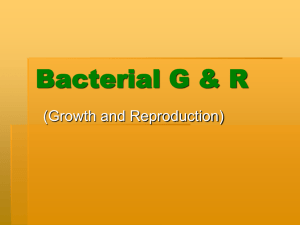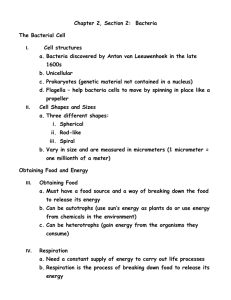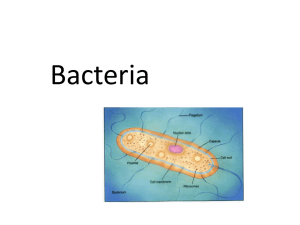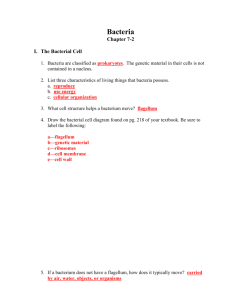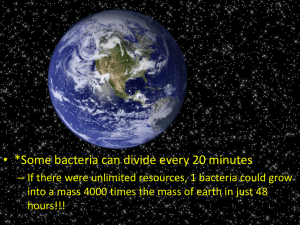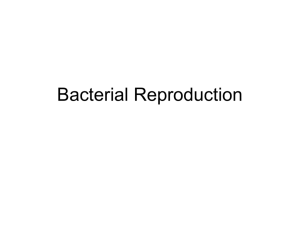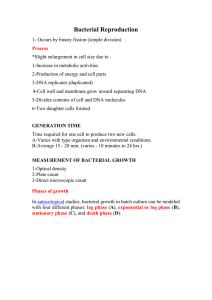Bacterial Growth & Reproduction
advertisement
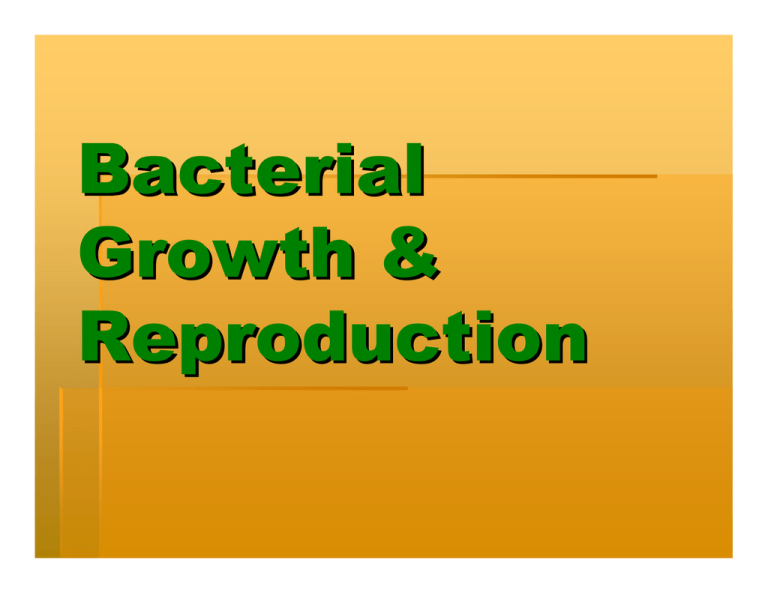
Bacterial Growth & Reproduction Types of Reproduction Asexual Sexual Spore Formation Asexual Reproduction a.k.a. Binary Fission Bacteria reproduce by splitting in two NO genetic diversity Rapid massive reproduction possible Binary Fission Sexual Reproduction a.k.a. Conjugation Pili form bridge between different bacteria Genetic material is transferred Genetic diversity RESULTS Allows bacteria to transfer resistance to antibiotics to other species (contained in genes) Conjugation Figure 8.25 Bacterial conjugation. The sex pilus connecting these cells undergoing conjugation allows the transfer of genetic information. At the actual time of genetic exchange, the cells’ connecting bridge contracts and the cells are much closer together. Notice that one cell has numerous fimbriae. QUESTION?? Why is sexual reproduction of bacteria bad for Humans? Bacteria can pass on resistance to antibiotics , even between species!!!!!! Spore Formation Endospores Formed under conditions of environmental stress Spores are thick walled & contain genetic information Extremely resistant to heat, desiccation (drought), cold, UV light, and toxic chemicals Spore Formation Spores that survive such conditions go on to become typical cells By being exposed to heat or chemicals = the spore takes on water, swells, and releases a vegetative (metabolically active/growing) cell Sporulation Nutrient & Energy Sources for Bacterial Growth Organic matter Carbon (from CO2) Sunlight Chemicals Environmental Factors That Influence Growth Temperature Oxygen Most pathogens grow between 41-140 oF (20-50 oC) Some require O2 and others do not pH Most bacteria grow in a range of pH 6.5-7.5 Few can survive below ~pH 4 Serious food contamination @ pH above ~5 Water Availability Bacteria need moisture Limits to Growth • pH <4.6 (acidic) • HOT and DRY environment • NO FOOD source • NO SPACE for growth How Do Bacteria Cause Disease? 1. Metabolize Host – Secretion of enzymes to “eat” host tissue 2. Produce Toxins – Bacterial waste can be toxic to host cells Controlling Growth & Prevention from Infection Sterilization = destruction/removal of all microorganisms (including endospores) Disinfection = removal of most (the harmful) microbes Used for surgical instruments Lysol wipes, etc. Pasteurization = mild heat treatment to rid consumables of spoilage microorganisms (not sterile) Milk Controlling Growth & Prevention from Infection Sanitization = microbes removed to a safe public health standard/level Restaurants Preservation = process to delay spoilage of consumable goods Cheese Controlling Growth & Prevention from Infection Antibiotics = a substance produced by microorganisms that in small amounts inhibits another microorganism Usually produced naturally by a bacteria or fungus Some are used to control bacterial growth in the body Others are put into foods to inhibit growth of food spoiling bacteria
